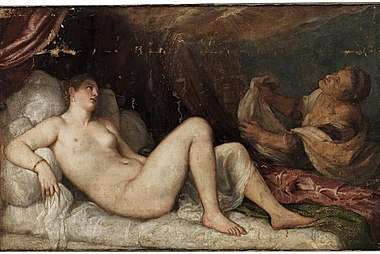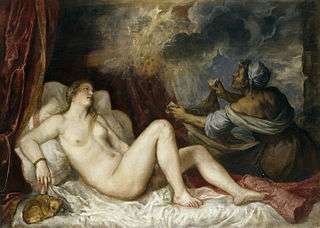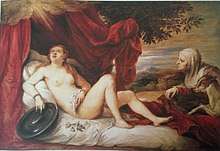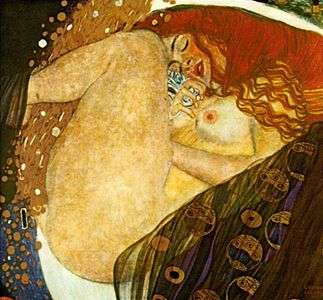Danaë (Titian series)



.jpg)

The Danaë (or Danaë and the Shower of Gold) series comprises at least five[3] oil-on-canvas paintings by the Venetian master Titian, completed between 1545-46 and about 1570. The works are based on the story of the mythological princess Danaë, as recounted by the Roman poet Ovid. She was isolated in a bronze dungeon following a prophecy that her firstborn would eventually kill her father.[4] Although aware of the consequences, Danaë was seduced and became pregnant by Zeus (in Roman mythology Jupiter), who, inflamed by lust, descended from Mount Olympus to entice her as a shower of gold.[5]
The first version, now in Naples, was painted between 1544-46, and is the only one with a figure of Cupid at the right, rather than an old woman catching the shower of gold. Titian executed a later version on commission from the art-loving Spanish monarch Philip II; since 2013 this version has been identified with one belonging to the Wellington family rather than the one in the Prado. In total Titian and his workshop produced at least five versions of the painting, which vary to degrees. The dog resting at Danaë's side in the Prado version is generally absent. The voluptuous figure of Danaë, with legs half spread, hardly changes.[6]
The works have been highly influential and affected the work of many artists including Rembrandt,[7] Anthony van Dyck and Gustav Klimt, who all painted versions of the scene. Giorgio Vasari recounts a visit with Michelangelo to Titian's studio, where they saw the original in progress. Michelangelo praised Titian's use of colour in the Madrid painting, though later, in private, he was critical of Titian's draftsmanship.[8]
Legend of Danaë
According to Greek mythology known by Titian through Ovid's Metamorphoses, when Acrisius consulted the oracle on how he would get male children, he was told that his daughter would bear a son who would kill him. Acrisius then locked up and guarded his daughter Danaë in a subterranean dungeon.[9] Danaë, aware of the consequences, allowed herself to be seduced and impregnated by Zeus, who persuaded her to lower her defenses by appearing in the form of a shower of gold.[10][11]
When Acrisius learned of Danaë's son Perseus, he refused to believe Zeus's role, and cast mother and child adrift at sea in a chest. They landed at Seriphus, where Perseus was raised by Dictys. Perseus eventually fulfilled the prophecy by killing Acrisius years after—although accidentally. There are a number of versions of Acrisius' death. In Pseudo-Apollodorus' version, when Perseus learns of the oracle he goes into voluntary exile in Pelasgiotis (Thessaly), where Teutamides, king of Larissa, is holding funeral games for his father. Perseus competes in the discus throw, but his missile veers and strikes Acrisius, killing him instantly.
Danaë was seen in the Middle Ages and Renaissance as a symbol of the corrupting effect of wealth, which could taint even feminine beauty or moral virtue.[7] An epigrammist in the Greek Anthology wrote of the legend of Danaë and Zeus:
Thou didst fall in a rain of gold on Danaë, Olympian Zeus, that the child yield to thee as to a gift...Zeus bought Danaë for gold...piercing the brazen chamber of Danaë, cut the knot of intact virginity. I think the meaning of the story is this "Gold the subduer of all things, gets the better of brazen walls and fetters, gold loosens all reins and opens every lock, gold makes the ladies with scornful eyes bend the knee. It was gold that bent the will of Danaë. No need to for a lover to pray to Aphrodite, if he brings money to offer.[11]
Series
The pose of Danaë remains unchanged in the various versions. She is shown naked or with a draped thigh, lying on a couch with her knees raised and her legs half-parted. Kenneth Clark sees as Titian adopting the conventions for the nude prevailing outside Venice; "in the rest of Italy bodies of an entirely different shape had long been fashionable".[12] Either a maid or, in the original in Naples, Cupid is to her right, the maid often holding out a cloth or dish to catch the gold coins spilling down from an explosion of colour in the sky which represents Zeus.[13] The left side of each canvas is an interior, although sometimes showing a distant landscape view. In keeping with the Renaissance view of Danaë, Titian has depicted her with the fleshy body of a courtesan,[14] although she is given the facial features of a graceful contemporary Venetian lady.[15] The Naples version suggests her fall from grace in a number of ways, including the presence of thunderous clouds, her now-complete nakedness, and the dog (sometimes used as a symbol of libertinism) curling to her left. The old woman's body is now turned fully towards the rain of gold, whereas Eros had his back to the skyscape, with his head turned back.
In the Madrid painting, the bedding is rendered in warm sensual colours of brown and pink framed by purple velvet drapes; the right side of the canvas contains cooler grey and blue tones.[15]

In the Naples version, the burst of light that showers coins and on which Danaë's heavy gaze falls is flanked by dark clouds that appear to be moving towards the centre of the canvas. They spill heavy rain, which falls parallel to Zeus's coins. In the Prado and subsequent versions, Cupid has been replaced by an old woman, whose undoubted unattractiveness, which is very pronounced in some versions, draws attention by comparison to the beauty of Danaë.[16] The greenish cast of her skin is set against the pale hues of the younger woman. Danaë parts her lips in pleasure, while the gold spills in greater quantity and with more velocity than in the Naples work. That painting is rendered in a looser manner; for example the folds of the bed linen and pillow are described with shorter more expressive brushstrokes.[17]
While the series freely describes desirable flesh in an overtly sexual manner, Titian transforms the motifs of courtesans and carnal desire into the more highbrow realm of classical myth.
Original, Naples version
The first version of the composition was painted in both Rome and Venice for Cardinal Alessandro Farnese, whose grandfather then reigned as Pope Paul III. The papal nuncio in Venice saw it in progress, and in September 1544 wrote cheerfully to the cardinal that compared to it, Titian's famous earlier nude, the Venus of Urbino looked like "a Theatine nun", and that it would arouse even Cardinal Tommaso Badia. At least "Theatrine" is usually assumed to mean a nun, although it has been suggested that the term was also a "term of abuse to refer to any "ultra-conservative Catholic" killjoy".[18]
The features of Danaë, which were broadly kept in the later versions, were based on those of the cardinal's mistress Angela; Giulio Clovio had sent Titian a likeness from Rome for him to use.[19] This version passed by descent through the Farnese family to the royal collection in Naples, and is now in the National Museum of Capodimonte, Naples.[20]
Philip II's version, and the Prado's
It is documented that King Philip II of Spain commissioned a second version, painted in 1549-50, as the first of a series of mythological paintings described by Titian as "poesie" ("poems").[21] Venus and Adonis, the next to be painted, was designed to be viewed alongside Danaë, although they are not same size.[22] Titian explained in a letter to Philip that the two paintings would offer contrasting front and rear views of a nude Venus, thus allowing painting to compete with sculpture.[23]
Until very recently it was assumed that the version now in the Prado was this one, but after it received cleaning and conservation at the Prado in 2103 it became clear that Philip's version, after spending some 250 years in the royal collection, was given to the Duke of Wellington, after the British army captured a carriage full of paintings from the Spanish royal collection at the Battle of Vitoria in 1813. Joseph Bonaparte, whose brother Napoleon had made him King of Spain, had already lost Madrid, escaping with over 200 paintings in the carriage. In 1816 the restored Bourbon King Ferdinand VII of Spain presented Wellington with the paintings that had been in the carriage.[24] The Arnolfini Portrait by Jan van Eyck was also in the carriage, but (being conveniently small) appears to have been looted by the soldiers, and next appeared in London in 1816 in the possession of a Scottish colonel who had been at Vitoria.[25]
Wellington's version, previously thought to be a copy, remains in the family, at Apsley House in London, but not in the parts of the house open to the public. It and two other Titians reattributed at the same time were briefly put on public exhibition there, for the first time, in 2015.[26]
The Prado's version is now agreed to be one painted around 1565, and only joining the Spanish royal collection in the 17th century, bought in Italy by Velasquez, and sold to Philip IV of Spain. It is of very high quality, and after the gift to Wellington took its place.[27] It is now shown in the same room in the Prado as their Venus and Adonis and other Titians.[28]
Other versions
There are other significant versions which are thought to be at least by Titian's workshop, with some involvement by the master, in particular those in the Hermitage Museum and the Kunsthistorisches Museum in Vienna. Titian's reclining nudes were extremely popular, and he was evidently often asked for repetitions. Other secular Titian compositions with several versions are the Venus and Adonis with which this was paired, and the Venus and Musician, with either an organist or a lute-player. Typically, as in this case, the main nude figure was traced from a record kept in the studio, but lesser figures and the background often more loosely copied, or freshly devised for each version.
Michelangelo

When Michelangelo and Giorgio Vasari visited Titian at his temporary studio in the Vatican Belvedere, they were shown a Danaë which was in the process of completion. While in the studio, Michelangelo highly praised Titian's use of colour, but later expressed reservations on his grasp of the "sound principles" of draughtsmanship and composition. James Northcote quotes Vasari's account of Michelangelo's words:
For I am conscious that if this man was as much assisted by art, as he is by nature, no mortal could go further. He has a noble spirit; but as of present having no knowledge of design, he in his imitations of the life corrects nothing nor attempts to make it better, though possessed of a manner so easy and beautiful, so full of truth and animation. But certain it is, that not having studied the best work of the ancients, the Venetians know not how to mend or how to give a grace and perfection to their works beyond their model, which is never perfect in all parts. The moderns in general cannot, from their own resources, be correct, but are obliged to make a literal copy of the object before their eyes, not knowing what it ought to be.[29]
Vasari's account needs to be treated within context; in his view draftsmanship — disegno — was the highest achievement in art, while colour was secondary. This belief may have led to his fabrication of the anecdote in order to give more weight to his views.[15]
- Influence


_Danae.jpg) Danae, Alexandre Jacques Chantron, 1891.
Danae, Alexandre Jacques Chantron, 1891. Gustav Klimt's Danaë, 1907. Klimt's debt to Titian is evident in the raised leg of the model
Gustav Klimt's Danaë, 1907. Klimt's debt to Titian is evident in the raised leg of the model
Mythological commissions

The Madrid version of Danaë is no longer thought to be part of the commission from Philip II for seven mythological paintings by Titian, but rather a later addition to the royal collection. It is displayed in the same room as Venus and Adonis from the original commission.
The poesie mythological series
- Danaë, delivered to Philip 1550, now Wellington Collection, with earlier and later versions.[30]
- Venus and Adonis, Museo del Prado, delivered 1554, and several other versions
- Diana and Actaeon, 1556-59, owned jointly by London's National Gallery and the National Gallery of Scotland in Edinburgh
- Diana and Callisto, 1556-59, owned jointly by London's National Gallery and the National Gallery of Scotland in Edinburgh
- Perseus and Andromeda, Wallace Collection, c. 1554-56
- The Rape of Europa, c. 1560-62, Isabella Stewart Gardner Museum
- The Death of Actaeon, National Gallery, never delivered, c. 1559 onwards
 Danaë
Danaë Venus and Adonis
Venus and Adonis Diana and Actaeon
Diana and Actaeon Diana and Callisto
Diana and Callisto Perseus and Andromeda
Perseus and Andromeda

In 2012, the National Gallery in London featured three of the paintings in an exhibition called Metamorphosis: Titian 2012.[31]
References
- ↑ Museum page
- ↑ "Danae nach 1554". Kunsthistorisches Museum. Retrieved 5 March 2010.
- ↑ Known versions are held in Naples, London, Madrid, Vienna and St. Petersburg.
- ↑ Amores. 2.19.27-8, ca. 25-16 BC.
- ↑ In some portrayals, notably Rembrandt's, Zeus is shown as a beam of light. See Westermann, 121
- ↑ Cavalcaselle, Giovanni Battista. The Life and Times of Titian: With Some Account of His Family. BiblioBazaar, LLC, 2008. 230. ISBN 0-559-78582-8
- 1 2 Sluijter, 225
- ↑ Northcote, 273
- ↑ Kahr, Madlyn Millner. "Virtuous, Voluptuous, Venal Woman". The Art Bulletin, 60/1, March 1978. 43-55
- ↑ Kaminski, 89
- 1 2 Santore, Cathy. "The Renaissance Courtesan's Alter Ego". Zeitschrift für Kunstgeschichte, 54/3, 1991. 412
- ↑ Clark, 122–123, 122 quoted
- ↑ Ridolfi, Carlo & Bondanella, Julia Conway. The Life of Titian. Pennsylvania State University Press, 1996. 117. ISBN 0-271-01627-2
- ↑ She was not often depicted as a prostitute until the 19th century. See Shell, Marc. Art & Money. Chicago University Press , 1995. 149.
- 1 2 3 "Danae". State Hermitage Museum. Retrieved on 4 March 2010.
- ↑ Prado; Kaminski, 106
- ↑ Jaffé, 132
- ↑ Loh, 32
- ↑ Jaffé, 132; NGA
- ↑ Museum page
- ↑ Kaminski, 105
- ↑ Falomir video; Penny, 203, says "probably" delivered in 1550.
- ↑ Penny, 284
- ↑ Apsley, 1; "Apsley House collection", English Heritage
- ↑ Campbell, Lorne, The Fifteenth Century Netherlandish Paintings, 176, National Gallery, 1998, ISBN 0-300-07701-7
- ↑ Apsley, 10
- ↑ Prado
- ↑ "Venus and Adonis". Museo Nacional del Prado. Retrieved 30 October 2015.
- ↑ Northcote, 273–274
- ↑ http://www.english-heritage.org.uk/about-us/search-news/wellingtons-titians
- ↑ National Gallery, Metamorphosis: Titian 2012
Sources
| Wikimedia Commons has media related to Danae by Titian. |
- "Apsley": "Titian at Apsley House", PDF, Exhibition Guide, 2015, English Heritage,
- Clark, Kenneth, The Nude, A Study in Ideal Form, orig. 1949, various edns, page refs from Pelican edn of 1960
- Hudson, Mark. Titian: The Last Days. London: Bloomsbury, 2009. ISBN 978-1-4088-0132-1
- Jaffé, David (ed), Titian, The National Gallery Company/Yale, London 2003, ISBN 1 857099036
- Kaminski, Marion. Titian. Ullmann, 2007. ISBN 978-3-8331-3776-1
- Loh, Maria H., Titian Remade: Repetition and the Transformation of Early Modern Italian Art, 2007, Getty Publications, ISBN 089236873X, 9780892368730, google books (full view)
- "NGA": "Italy to Lend Prized Titian Painting to National Gallery of Art to Celebrate Commencement of EU Presidency", June 19, 2014, National Gallery of Art press release
- Northcote, James. The life of Titian: with anecdotes of the distinguished persons of his time. Volume II. London : H. Colburn and R. Bentley, 1830.
- Penny, Nicholas, National Gallery Catalogues (new series): The Sixteenth Century Italian Paintings, Volume II, Venice 1540–1600, 2008, National Gallery Publications Ltd, ISBN 1857099133
- "Prado": "Danaë and Venus and Adonis", Exhibition feature
- Sluijter, Jan Eric. Rembrandt and the female nude. Amsterdam University Press, 2006. ISBN 90-5356-837-9
- Westermann, Mariët. Rembrandt. London: Phaidon, 1999. ISBN 0-7148-3857-8
